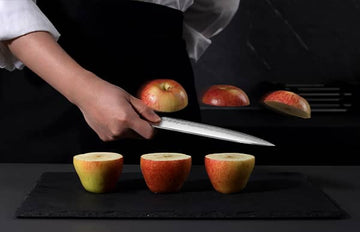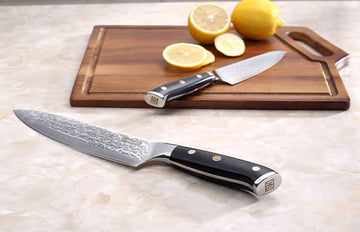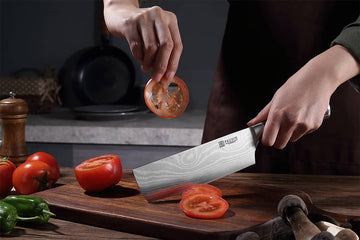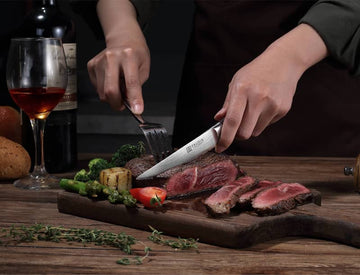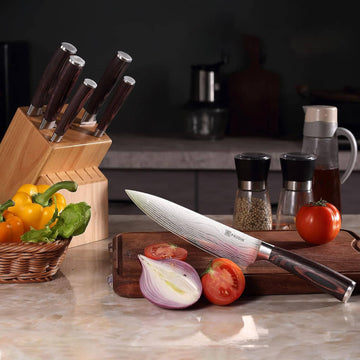Why Do You Need a Chef's Knife?
As a versatile knife, your chef's knife is a veritable tool for all parts of the kitchen.
What makes a Chef's Knife unique is the curved blade and large tang, allowing you to rock the knife back and forth. The ability to move your blade allows for easy and uniform cutting of any food item.
What to Check When Buying
What Steel is Best for Knives?
There are three standard options for knife steel:
- Damascus Steel - Know for hardiness. It takes a bit more effort to sharpen
- Carbon Steel - Known for hardiness and low corrosion resistance
- Stainless Steel - Known for sharpness, hardiness, and high corrosion resistance
All three can be excellent blade metals. However, stainless steel is typically the most popular due to its broad appeal and natural corrosion resistance.
Rockwell Hardness
The Rockwell Hardness Scale determines the load-bearing capabilities of a material. For example, the Ultra Dark Premium 8" Chef's Knife has about 58 on the Rockwell Hardness Scale.
Higher hardness does not provide the best advantage for blades. In fact, it is best to have a hardness between 58 and 62. The higher number (62) represents the hardness of Damascus steel knives.
Slightly lower is 58, ensuring the blade doesn't have too much hardness. Higher hardness on thin pieces of steel makes blades more fragile, meaning they can break if you drop them. Meanwhile, a slightly lower hardness score keeps blades flexible and durable for long-lasting sharpness.
What is the Best Size for Chef's Knives?
The average length of a chef's knife is eight inches. This length is about average for your blade edge.
Some will tell you that they prefer a six-inch blade or a twelve-inch blade. It would be best if you ideally had an edge about the length from your elbow to your wrist.
The grip should fit comfortably in your hands regardless, so try out the feel of the knife to determine what is right.
What is a Good Knife Tang?
A knife tang is the metal part that extends into the handle. Without a tang, your knife would be stuck on the edge of the handle. That would make it fall apart during any hard-cutting session.
There are two primary tang forms:
- Full Tang - A full tang has the metal reach through the entirety of your knife handle.
- Partial Tang - A partial tang only reaches somewhat into your handle. It is sometimes called a half tang or stub tang.
Full tang knives are made with a single piece of steel stretched out along the entirety of your surface. The extra steel ensures long-lastingness but at a higher weight.
A partial tang isn't weak with modern manufacturing techniques. However, it is still less durable. However, it does make up for that by being far lighter.
Depending on your priorities, both options could be viable for your needs.
What is a Good Weight for Blades?
A good chef's knife has a bit of weight to it. A heavy knife means it likely has a full tang and is made with multiple layers of steel. Also, shorter blades should have heavier handles to account for ease of control. A "good" weight means you have a balanced blade where the handle and the blade side are comparable.
It's best if you work with multiple knives to determine how "loose" you'd like them to feel. A heavier knife results in more chopping force but requires more effort. A lighter knife is better for delicate tasks and free-flowing movement.
When to Use the Chef's Knife
A chef's knife is one of the most versatile pieces of kitchen equipment in your arsenal. You can use it for these purposes:
Slicing and dicing meat (or fish)
- Chopping herbs
- Cutting vegetables
- Chopping nuts
You should avoid using it in these situations:
- Cleaving meat bones
- Slicing bread
- Small precision tasks (peeling and mincing)
Our Chef's Knives (Pros & Cons)
Paudin Pro Knives has a wide variety of chef's knives to meet a variety of needs. Here's a shortlist of them alongside their pros and cons:
Universal and Hammered Vintage


|
Pros |
Cons |
|
Cost-effective |
Not dishwasher safe |
|
Aesthetically beautiful |
|
|
Ergonomic blade handle |
|

|
Pros |
Cons |
|
A great combination of beauty and toughness |
Not In Everyone's Budget |
|
Offers many knives with multiple applications |
|
|
Incredibly sharp and cleans easily |
|

|
Pros |
Cons |
|
Traditional german knife |
Some people don't like the conventional design |
|
The bolster provides extra safety |
|
|
Sharpened for more precise cutting |
|

|
Pros |
Cons |
|
Simple and low-maintenance |
|
|
High wear resistance |
|
|
Well-balanced blade |
Full tang makes this heavier |
Gordes and Gordes Pro


|
Pros |
Cons |
|
Gordes Pro has a unique design element |
The knife is heavier than others |
|
Made of German stainless steel |
Not for smaller hands |
|
"fish belly" handle makes it easy to grip |
|

|
Pros |
Cons |
|
Easy-grip position |
The non-traditional design takes some getting used to |
|
Full tang makes this knife perfectly balanced |
|

|
Pros |
Cons |
|
It has a unique design |
Some people might not like the unique design |
|
It has a handmade handle |
|
Conclusion
A Chef's knife is the ultimate in tool versatility for your kitchen. As some of the most flexible blades in existence, all kitchens need to make room for chef knives on their list.
If you'd like to complete your kitchen toolset with a new chef knife, consider Paudin's line of available knives.
